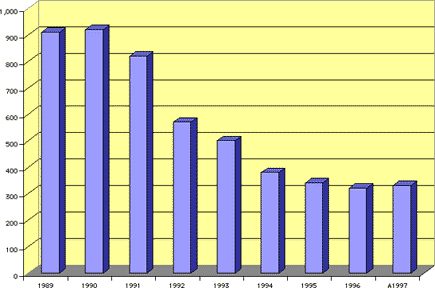|

TAJIKISTAN
|
GDP PPP (2008 est.): $13.8 billion.
GDP nominal per capita (2003)
U.S.. Purchasing power parity is about $18000.
GDP real growth rate (2008 est.):3.4%.
Inflation rate: 6.4%.
Main Crops: Cotton, grain, fruits, grapes, vegetables; cattle, sheep, goats.
Natural Resources: Hydropower potential, some petroleum, uranium, mercury, brown coal, lead, zinc, antimony, tungsten .
Major Industries: Aluminum, zinc, lead, chemicals and fertilizers, cement, vegetable oil, metal-cutting machine tools, refrigerators and freezers .
|
| NATIONAL GNP |
 |
|
Tajikistan has one of the lowest per capita GDPs among the 15 former Soviet republics. Because of a lack of employment opportunities in Tajikistan, nearly half of the labor force works abroad, primarily in Russia and Kazakhstan, supporting families in Tajikistan through remittances. The exact number of labor migrants is unknown, but estimated at around 1 million. Less than 7% of the land area is arable. Cotton is the most important crop, but this sector is burdened with debt and obsolete infrastructure. Mineral resources include silver, gold, uranium, and tungsten. Industry consists only of a large aluminum plant, hydropower facilities, and small obsolete factories mostly in light industry and food processing. The civil war (1992-97) severely damaged the already weak economic infrastructure and caused a sharp decline in industrial and agricultural production. Tajikistan's economic situation remains fragile due to uneven implementation of structural reforms, corruption, weak governance, widespread unemployment, seasonal power shortages, and the external debt burden. A debt restructuring agreement was reached with Russia in December 2002, including a $250 million write-off of Tajikistan's $300 million debt. Completion of the Sangtuda I hydropower dam - finished in 2009 with Russian investment - and the Sangtuda II and Rogun dams will add substantially to electricity output. If finished according to Tajik plans, Rogun will be the world's tallest dam. Tajikistan has also received substantial infrastructure development loans from the Chinese government to improve roads and an electricity transmission network. To help increase north-south trade, the US funded a $36 million bridge which opened in August 2007 and links Tajikistan and Afghanistan. While, Tajikistan has experienced steady economic growth since 1997, nearly two-thirds of the population continues to live in poverty. Economic growth reached 10.6% in 2004, but dropped below 8% in 2005-08, as the effects of higher oil prices and then the international financial crisis began to register - mainly in the form of lower prices for key export commodities and lower remittances from Tajiks working abroad, due to the global economic downturn. In 2009 GDP growth dropped to 3.4% as a result of the world recession.
|
|
|


